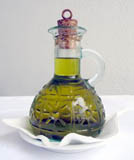
Purpose
To determine whether vinegar is just as effective as a cleaning agent as a chemical-based supermarket cleaner.
Additional information
The biosphere is at danger. As wonderful as technology has been in enhancing our lives and creating longevity, it's also been a double-edged sword. Human activity and the constant drive to expand has come at the expense of the global environment. Greenhouse gases are contributing to global climate warming as emissions caused by human activity continue to increase. The depletion of the ozone layer, essentially the protector of life on earth, has never been greater. Chemical agents sprayed into the atmosphere rise-upward and take their toll on the ozone and our environment. Empty containers often end up in landfills indefinitely. We need to do our part and take action now through use of natural and biodegradable products.
Sponsored Links
Required materials
- Diluted vinegar
- Supermarket cleaning product that is safe on glass (such as Windex)
- Cleaning cloth
- Old newspaper
Estimated Experiment Time
Less than 5 minutes
Step-By-Step Procedure
- 1. Find a dirty mirror or window. It should be a surface that is visibly dirty all-around.
- 2. Scrunch up your newspaper and pour some vinegar on it. The paper should be saturated, but only so it's partially wet with vinegar (enough to clean the surface). Scrub one-half of the window/mirror for about a minute, making sure to scrub in a swooping circular motion.
- 3. On the second-half of the window, spray your supermarket cleaning agent. Take your cleaning cloth and clean the second-half of the window for a minute, usnig the same swooping circular hand motion.
- 4. When you're done, observe the window / mirror. Which half is cleaner? Is there a noticeable difference?
Note
With an eye on the environment (and the consumer pocket-book), many big-name companies are starting to jump on the "natural" bandwagon. You'll find more natural-based cleaners these days than in the past, but be weary of labels! Some companies use clever marketing gimmicks to make their products appear to be "natural", when in fact they are not. A common ploy is to label a bottle with "natural orange/lemon scent". When a consumer glances at the product they see "natural" and assume the cleaner is natural. Always check the listed ingredients to see if the product you’re purchasing is truly made of natural ingredients.
Observation
Which method of cleaning the window do you think is the most environmentally friendly? Was there enough of a different between the chemical cleaning agent and the vinegar to justify its use and its potential negative effects on the environment?
Result
In most cases, there is little to no difference in the result of the window cleaning. Many supermarket cleaners contain harsh chemicals that are dangerous to the environment and atmosphere. Vinegar is a non-toxic acidic liquid that can clean just as effectively as many chemical based agents, without the damaging side-effects. The newspaper was used to demonstrate how recycled material can make a viable substitute for cleaning clothes, which requires a lot of energy to produce.
Sponsored Links
Take a moment to visit our table of Periodic Elements page where you can get an in-depth view of all the elements,
complete with the industry first side-by-side element comparisons!